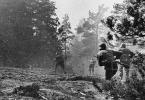Palace of Elizabeth Petrovna -
Barracks of the Pavlovsk Grenadier Regiment - LenEnergo Building
Field of Mars st., 1-5
Millionnaya st., 2
Aptekarsky lane, 2
Architects: Stasov V. P.
Year of construction: 1817-1821
Style:Barracks of the Pavlovsk Grenadier Regiment
1730-1740s - the palace of Elizabeth Petrovna, the house of the physician I. Lestok.
1780 - architect. Yu. M. Felten - Orphanage.
Barracks of the Kexholm Regiment
1817-1821 - arch. Stasov V.P. - Barracks of the Pavlovsk Regiment.
1820 - Church of St. Prince Alexander Nevsky.
1860-1862 and 1885 - partial change of interiors.
1928-1929 - sculptor Rassadin - changing the bas-relief ch. Attica.Classicism
One of the first houses on the street. The Field of Mars was the home of General A. A. Weide, the compiler of the first Military Regulations in Russia.
In the 1730-1740s. on the site there was a palace of Peter's daughter Elizabeth - the former house of A. L. Naryshkin, bought by the treasury in 1732.
The palace of Elizabeth Petrovna became the center of the conspiracy that led to her accession to the throne. Nearby was the house of physician I. Lestok, an active participant in the coup.
Elizabeth gave her palace and house of Lestocq to her favorite A.G. Razumovsky. Some historians believe that Razumovsky and Elizabeth secretly got married in 1742.
In 1761, both Razumovsky houses were purchased by the treasury and demolished in 1770.
In 1780, according to the project of architect. Yu. M. Felten erected a huge three-story pawnshop building on this site.
In 1784, the building was adapted for an Orphanage - trustee I. I. Betsky. A large reward was given for bringing babies.
In 1797, the Orphanage was moved to the Moika.
The barracks of the Kexholm regiment, formed in 1710 as a grenadier regiment, are located here.
In 1817-1821 On the site of the Orphanage, regimental barracks were built to house the Pavlovsk Grenadier Regiment according to the design of V.P. Stasov.
Sculptural decoration by V. I. Demut-Malinovsky (presumably).
In 1820 the Church of St. Prince Alexander Nevsky.
In 1860-1862 and 1885. partial changes to the interiors were carried out.
In 1928-1929 the sculptor Rassadin changed the bas-relief in the upper part of the main attic - the royal symbols were removed.
The Pavlovsk regiment was formed in 1796 under Paul I.
In memory of the founder, they were formed by short blondes or redheads, with freckles and snub noses (?). Disbanded 1918
Until 1928, the building was empty and served as a shelter for street children.
In 1928 it was transferred to Elektrotok - later to Lenenergo.
In Razumovsky's house in the 1740s. The writer A.P. Sumarokov lived as an adjutant.
Church of St. blgv. Prince Alexander Nevsky in the barracks of the Life Guards Pavlovsky Regiment
In 1818, the commander of the Pavlovsk regiment, Major General K. I. Bistrom, began rebuilding the barracks building along the western border of the Champs de Mars according to the design of V. P. Stasov
In 1820, a church was built in the barracks, located in the central part of the building on the second floor.
The interior of the church was decorated in a classical style according to the design of V.P. Stasov in 1822-1823. After this, the church was consecrated. The church hall, which could accommodate 900 people, was located on the second floor. Along the perimeter there was an Ionic colonnade supporting the choir. The ceiling was painted by J.B. Scotti. The carved iconostasis was divided by pilasters.
The church was closed in 1918.
In 1928-1929 arch. O.R. Muntz rebuilt the premises as a club. The iconostasis and paintings were destroyed, the decoration of the room was significantly changed. There was a stage in the altar area.
www.citywalls.ru/house1894.html
In 1816, an institution was created in St. Petersburg with a long and inconvenient name, which, however, very accurately reflected its purpose - “The Committee to bring into better order all buildings and hydraulic works in St. Petersburg and the places touching thereto.” The Committee's tasks included the improvement of buildings in the city, the construction of new streets, canals, the construction of embankments, issues of water supply and fire safety. The government decree stated that the Committee’s duty was to put St. Petersburg in order “to such a degree of beauty and perfection that in all respects, corresponding to the merits, would also combine private benefit...”.
Architect Vasily Stasov became one of the members of the Committee. His first job in his new position was to tidy up and improve the Campus Martius. The task was important, because the field with a huge territory (500 m by 300 m) was located in the very center of the city, next to the Summer Garden, Mikhailovsky Castle, and the Marble Palace. During the time of Peter I, this huge space was low and swampy; to drain it, two straight canals were dug - Lebyazhy and Krasny, and the field itself was called the Tsarina's Meadow - the palace of Catherine I stood here. During the holidays in the Summer Garden, fireworks were displayed on the field, or, as they said then, “Amusing Lights” - hence the second name - “Amusing Field”. By the end of the 18th century, the Red Canal was filled up, and the field increasingly began to be used for military parades and reviews. At the beginning of the 19th century, after the victorious end of the Patriotic War, the field was renamed Marsovo in the European manner.
Since the end of the 18th century, the buildings located along the edge of the field housed the Pavlovsk Grenadier Regiment. The regiment's command more than once raised the issue of expanding the premises; they tried to rebuild the buildings, but by 1816 a decision was made to build new barracks that would meet all the requirements. Vasily Stasov took up the design of the new building.
The permanent location of the guards regiments in St. Petersburg were small houses that were built behind the Fontanka, even the streets where these houses stood were called Rotami (current Krasnoarmeysk streets). An exception was made for the Pavlovsky Regiment. The Pavlovians became famous in battles with Napoleon’s army back in 1806-1807, when for their courage they received an unusual reward: the military administration decided “to honor this regiment, the hats currently in it should be left in the same form as he left the battlefield, even if some of them were damaged.” The fact is that the grenadiers wore traditional high hats - "mitres" - made of leather with a metal forehead, which at the beginning of the 19th century were already replaced by shakos in the Russian army. The caps of the soldiers of the Pavlovsky Regiment were even stamped with the names of those to whom they belonged.
These personalized caps of the heroes of the war with Napoleon, often even shot through, were handed over to the best privates of the regiment as ceremonial accessories until the beginning of the 20th century. The Pavlovsk regiment also became famous during the hostilities in 1812, for which, at the suggestion of Kutuzov, they began to call it the Life Guards. Another reward for the heroes was new barracks built in the city center.
The barracks of the Pavlovsk Regiment, designed and built by V. Stasov, became a real grandiose structure, more like a strict public building. The huge façade stretched along the Champ de Mars for almost 155 meters from Millionnaya Street to the Moika embankment and concealed a whole complex of structures for various purposes - the barracks themselves, the church, the stables, the kitchens, the hospital, and warehouses. The building of the barracks of the Pavlovsk regiment so naturally became part of the ensemble of the Champs de Mars that it seems simply inseparable from it.
In the 30s of the 19th century, the artist G. Chernetsov painted a huge canvas “Parade to mark the end of hostilities in the Kingdom of Poland on October 6, 1831 on Tsaritsyn Meadow in St. Petersburg.” The painting depicts a solemn military parade, which was held on the Field of Mars (or, as they used to say then, Tsaritsyn Meadow). The parade is attended by famous people of St. Petersburg who actually lived at that time - from Tsar Nicholas I to famous artists, writers, and even St. Petersburg beauties. In this picture, the Field of Mars seems especially large because, probably, right up to its very edge the audience sees strict and beautiful military columns. On the right side along the field is a long, low building, which also seems like a ceremonial military formation - this is the barracks of the Pavlovsk regiment. Today, when the time of military parades on the Champ de Mars is far in the past, thanks to this picture one can personally appreciate the tactfulness and at the same time the scale of Stasov’s architectural talent - so harmonious and natural is his creation, outwardly very modest and strict, emphasizing the purpose of the huge square.
Bank St. Petersburg has gained control over Lotus Hotels LLC, previously owned by the strategic investor Plaza Lotus Group, Kommersant reports. Together with the company, the bank received a project for the reconstruction of a cultural heritage site into a fashionable hotel - the former building of the barracks of the Pavlovsky Life Guards Regiment, the former office of Lenenergo on Marsovo Pole, 1a in the center of St. Petersburg.
Lotus Hotels LLC was included in the list of bank affiliates in October. As representatives of the bank told the publication, 80% of the company’s shares were bought by a closed mutual fund under the management of the structure of the bank “St. Petersburg - Management Company “BSPB Capital”. A 20% share passed to the bank as a result of negotiations with Plaza Lotus Group for the debts of Lotus Hotels - the bank received full control over the project.
The initial version involved the reconstruction of a historical building with an area of 24.7 thousand square meters. m for a hotel with 200 rooms. There were other options. The last one is LLC St. Petersburg Architectural Association of L. A. Litvinov. In this option, the total area of the hotel should be 43.9 thousand square meters. m. It was planned to accommodate 108 rooms, including 16 two-level apartments. On the underground floor there is a cinema room, billiards, living room, library, on the ground floor there is a bedroom with a dressing room, a dining room and a kitchenette, on both tiers there are bathrooms and bathrooms.
In addition, it was planned to build a fitness and health center in the basement with a swimming pool, hydromassage complex, baths and a medical office. Underground parking for 97 cars is designed under all three courtyards.
The project also involved the restoration of facades, sculptural groups on the attics and the parapet wall, which was lost during repeated roof repairs.
The approximate volume of investment in the project was initially estimated at 3.5 billion rubles. The bank intends to invest 5 billion rubles and complete the project independently or attract an investor. Although the project was approved by Glavgosexpertiza of Russia in December 2016, and permission for reconstruction was issued in June last year, the final parameters of the project are still not determined.
The reconstruction permit is valid until the end of 2022.
According to the publication, the bank is now suing two other structures of the strategic investor Plaza Lotus Group - Plaza Lotus Group LLC and Orange-Development JSC, seeking 221.6 million rubles for debts on the project on Primorsky Avenue. The company also received this site as a target for the construction of a hotel as part of a strategic project.
Photo: Paper
st. Zastavskaya, 31, building 2 196084 St. Petersburg,| Found an error or inaccuracy? Press CTRL and ENTER and tell us about it |
Also on topic
| 30.08.2019 16:32 |
Energy workers want to leave the historical building in the center of St. Petersburg on the Field of Mars, no. 1. Lenenergo has been located at this address since 1929.
According to the general director of OJSC Territorial Generating Company N1 (TGK-1), Andrei Likhachev, it is inappropriate for the companies spun off from Lenenergo and now “living” in the building on the Field of Mars to use a monument of federal significance for their needs. According to Likhachev, it would be more reasonable to use this building as a hotel or office center.
Lenenergo rented a building on the Field of Mars from the Federal Agency for Federal Property Management. The ten year lease expires after 8 years. After the reorganization of Lenenergo, the lease rights were transferred to OJSC North-West Energy Management Company.As Likhachev suggested, the energy sector will be able to vacate the building in a year or two, without waiting for the lease to expire: “If this is not done, then both the historical building itself, which requires significant repair costs, and the companies that need to pay considerable rent will suffer.” Now Lenenergo structures pay about $3 million a year in rent.
However, the energy sector does not want to completely leave the Field of Mars. “The North-West Energy Management Company is ready to carry out preliminary work on the project for repurposing the building on the Champ de Mars and subsequently become a participant in this project,” Likhachev said.
The appearance of a free area of 20 thousand square meters in the historical center of St. Petersburg. m can become an extremely attractive investment object. According to the director of the Bekar - Commercial Real Estate company Igor Gorsky, it is possible to create a class A business center in the building on Marsovo Pole, no. 1. After reconstruction, which will cost at least $500 per 1 sq. m. m, the cost of renting premises in this building can be from $70 per sq. m. m. It is possible that the building will be transferred to the trust management of a management company (according to the law on property management).According to some St. Petersburg commercial real estate experts, who wished not to give their names in the publication, the Pavlovsk Barracks building is a “tidbit” for investors specializing in organizing the hotel business.
However, there are other opinions. As suggested by Leonid Kim, a specialist in the commercial real estate department of the Ithaca Academy of Sciences (St. Petersburg), “it is unlikely that this building will be repurposed as a hotel complex or business center. Most likely, it could house some department of the federal center.” The building occupied by Lenenergo is one of the federal monuments, which is located in an iconic place in St. Petersburg, and there are not many such objects in the city today. “Apparently there are a lot of people interested in this “delicious” building, and, most likely, if there is a queue for it, it will be not in St. Petersburg, but in Moscow. They won’t just let anyone near this historical monument,” noted Leonid Kim.
It can be assumed that the offices of large companies that intend to re-register in St. Petersburg can be located on Marsovy Pole, 1. This week, St. Petersburg Governor Valentina Matvienko confirmed that negotiations are currently underway with the management of Gazprom and the Government of the Russian Federation on the re-registration of Sibneft in the Northern capital. “There is already an understanding that in a city of five million there must be large taxpayers,” the governor said. According to her, the city government is making a lot of efforts to ensure that such a decision takes place, but it is too early to talk about results.
Let us recall that Vneshtorgbank and Transneft have already been re-registered in St. Petersburg, and it is expected that Transnefteproduct (TNP) and Sovcomflot will be re-registered in the Northern capital.
Tatyana Vilde, Rosbalt news agency, St. Petersburg
25/04/2014
Two councils - the Council for Cultural Heritage under the city government and the Scientific Expert Council of the St. Petersburg branch of VOOPIiK - approved the concept of adapting the Pavlovsk Barracks building on the Field of Mars, where Lenenergo moved out, into a superhotel.
P The transformation of the office building into a hotel is being carried out by the Plaza Lotus Group company of the Zingarevich brothers. In 2010, the hotel project was created by architect Rafail Dayanov. Two years later, at the St. Petersburg Economic Forum 2012, the ideas of Andrei Litvinov, called to replace Dayanov, gained scandalous fame. Litvinov proposed building a fountain on the Champ de Mars and attaching a magnificent vestibule to the classic barracks building. These sketches, however, did not have official status. There was a lot of outraged public response. Then the developers returned to Dayanov.
He did without fountains. There should be no changes to the outside of the building, except for the strip skylights on the roof. The rooms with views are hidden behind them.
Cultural heritage specialists on both councils agreed with the possibility of building underground parking and even covering two of the three courtyards, except the front courtyard, at the ground floor level.
The main problem is that in order to expand the number of rooms by a third (the hotel has a total capacity of 200 rooms), it is necessary to build a rectangular building inside the middle of the three courtyards. Thus, the protected internal courtyard facades will become the internal walls of the building.
When this proposal came up for examination by Mikhail Milchik, deputy director of the Spetsproektrestavratsiya institute, who was invited to conduct a state examination, he refused this work. In his opinion, the new type of middle courtyard will change the Stasov volumetric-spatial solution, which is the main subject of protection of the barracks.
But there were more supporters of the hotel. However, they also persistently recommended that the developer make the roof glazing so that at night the light would not shine from the roof. Otherwise, the appearance of the monument will be hopelessly damaged.
According to our data, the reconstruction of the Pavlovsk barracks should be completed in 2017 and will cost 200 million euros.
Reference
The barracks of the Life Guards Pavlovsky Regiment were built in 1817-1821 according to the design of Vasily Stasov. In plan, the building is a rectangular trapezoid with facades facing the Field of Mars, Millionnaya Street and Aptekarsky Lane. Inside there are three courtyards: front, middle, service. Lenenergo occupied the Pavlovsk barracks from 1929 to 2010 .
Vadim SHUVALOV, photo
The building of the barracks of the Pavlovsk regiment is located on the site where in the 18th century there were houses of eminent nobles, including Prince A.G. Razumovsky, and the city pawnshop building, built by the architect Yu.M. Felten. The majestic barracks building on the Champ de Mars is a magnificent creation of the outstanding Russian architect Vasily Petrovich Stasov.
The Pavlovsk regiment was formed by order of Peter the Great. The regiment received particular glory during the Patriotic War of 1812. He participated in military operations at Borodino, in the battles near the village of Klyastitsy, on the Berezina River and others. In 1813, the regiment was awarded the St. George Banners. He also received the honorary title of "Life Guards Pavlovsky".

Construction of the barracks building on the site between the Field of Mars, Millionnaya Street and Apothecary Lane began in 1817. Since 1819, the Pavlovsk regiment was already stationed here. The main façade of the building faces the Champs de Mars. On the attic there was an inscription: “Barracks of the Life Guards of the Pavlovsk Regiment.” The facade stretches for more than one hundred and fifty meters, and is accentuated by three Doric porticoes. The two side six-column porticoes of the building are completed with a pediment, and the large central twelve-column one is completed with an attic. Characteristic of Stasov is the rather sparse decoration of the building with sculptural decorations. The facade of the barracks, facing Millionnaya Street, is accented by a ten-column Doric portico. On the reliefs decorating the pediments and attic of the building, mainly military armor, banners, shields, etc. The building of the barracks of the Pavlovsk regiment completed the architectural ensemble of the adjacent square. It is a magnificent monument of Russian classicism architecture of the first half of the 19th century.

The interior of the barracks is devoid of any artistic design, which is naturally explained by the purpose of the building. One can only note the church hall with its Ionic colonnade, typical of the state halls of the early 19th century. In the thirties of the 20th century, it was somewhat rebuilt according to the design of the architect O. Muntz, turning into a club room. Currently, the Lenenergo cultural center is located here.

After the revolution, the Pavlovsky regiment was disbanded. During World War II, the building was hit by several air bombs and artillery shells. But by 1948, the facades of the barracks had been restored. Today, the Lenenergo administration is located in the former barracks of the Pavlovsky Regiment.




